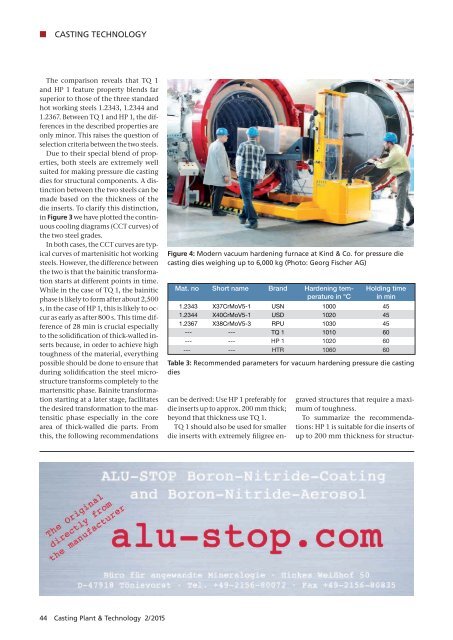CPT International 02/2015
The leading technical journal for the global foundry industry – Das führende Fachmagazin für die weltweite Gießerei-Industrie
The leading technical journal for the
global foundry industry – Das führende Fachmagazin für die
weltweite Gießerei-Industrie
Create successful ePaper yourself
Turn your PDF publications into a flip-book with our unique Google optimized e-Paper software.
K CASTING TECHNOLOGY<br />
The comparison reveals that TQ 1<br />
and HP 1 feature property blends far<br />
superior to those of the three standard<br />
hot working steels 1.2343, 1.2344 and<br />
1.2367. Between TQ 1 and HP 1, the differences<br />
in the described properties are<br />
only minor. This raises the question of<br />
selection criteria between the two steels.<br />
Due to their special blend of properties,<br />
both steels are extremely well<br />
suited for making pressure die casting<br />
dies for structural components. A distinction<br />
between the two steels can be<br />
made based on the thickness of the<br />
die inserts. To clarify this distinction,<br />
in Figure 3 we have plotted the continuous<br />
cooling diagrams (CCT curves) of<br />
the two steel grades.<br />
In both cases, the CCT curves are typical<br />
curves of martenisitic hot working<br />
steels. However, the difference between<br />
the two is that the bainitic transformation<br />
starts at different points in time.<br />
While in the case of TQ 1, the bainitic<br />
phase is likely to form after about 2,500<br />
s, in the case of HP 1, this is likely to occur<br />
as early as after 800 s. This time difference<br />
of 28 min is crucial especially<br />
to the solidification of thick-walled inserts<br />
because, in order to achieve high<br />
toughness of the material, everything<br />
possible should be done to ensure that<br />
during solidification the steel microstructure<br />
transforms completely to the<br />
martensitic phase. Bainite transformation<br />
starting at a later stage, facilitates<br />
the desired transformation to the martensitic<br />
phase especially in the core<br />
area of thick-walled die parts. From<br />
this, the following recommendations<br />
Figure 4: Modern vacuum hardening furnace at Kind & Co. for pressure die<br />
casting dies weighing up to 6,000 kg (Photo: Georg Fischer AG)<br />
Mat. no Short name Brand Hardening temperature<br />
in °C<br />
Holding time<br />
in min<br />
1.2343 X37CrMoV5-1 USN 1000 45<br />
1.2344 X40CrMoV5-1 USD 1<strong>02</strong>0 45<br />
1.2367 X38CrMoV5-3 RPU 1030 45<br />
--- --- TQ 1 1010 60<br />
--- --- HP 1 1<strong>02</strong>0 60<br />
--- --- HTR 1060 60<br />
Table 3: Recommended parameters for vacuum hardening pressure die casting<br />
dies<br />
can be derived: Use HP 1 preferably for<br />
die inserts up to approx. 200 mm thick;<br />
beyond that thickness use TQ 1.<br />
TQ 1 should also be used for smaller<br />
die inserts with extremely filigree engraved<br />
structures that require a maximum<br />
of toughness.<br />
To summarize the recommendations:<br />
HP 1 is suitable for die inserts of<br />
up to 200 mm thickness for structur-<br />
44 Casting Plant & Technology 2/<strong>2015</strong>


















